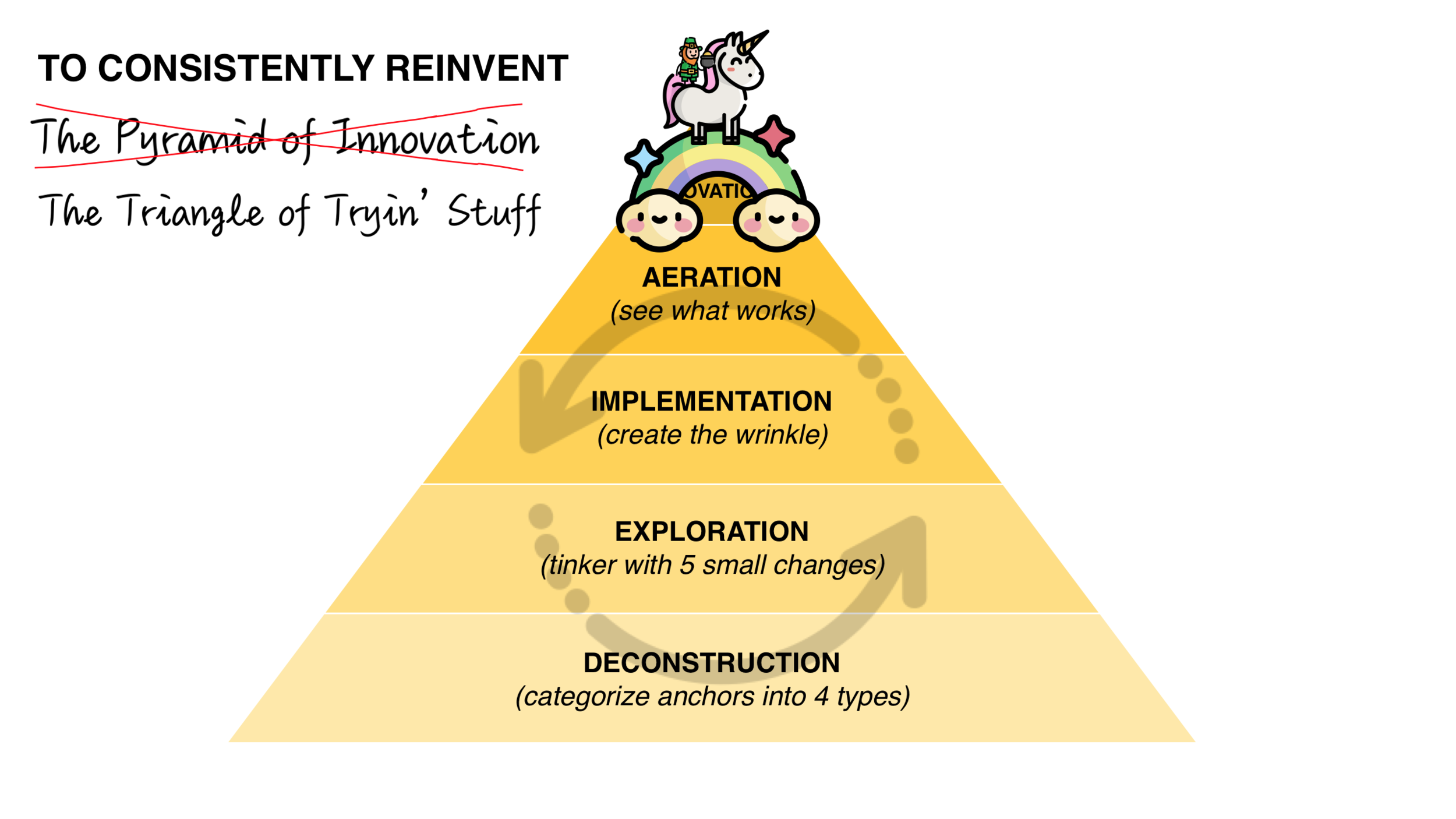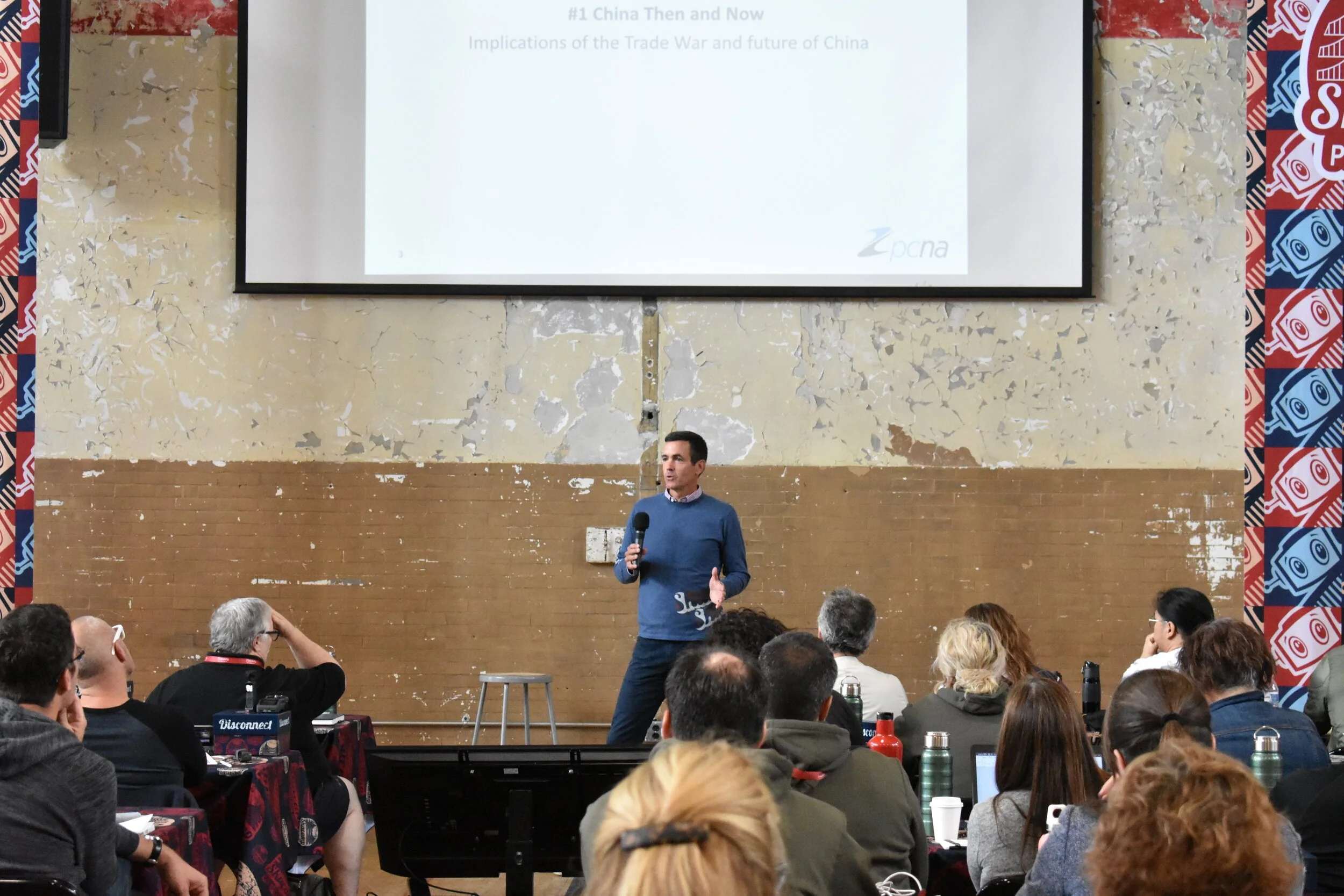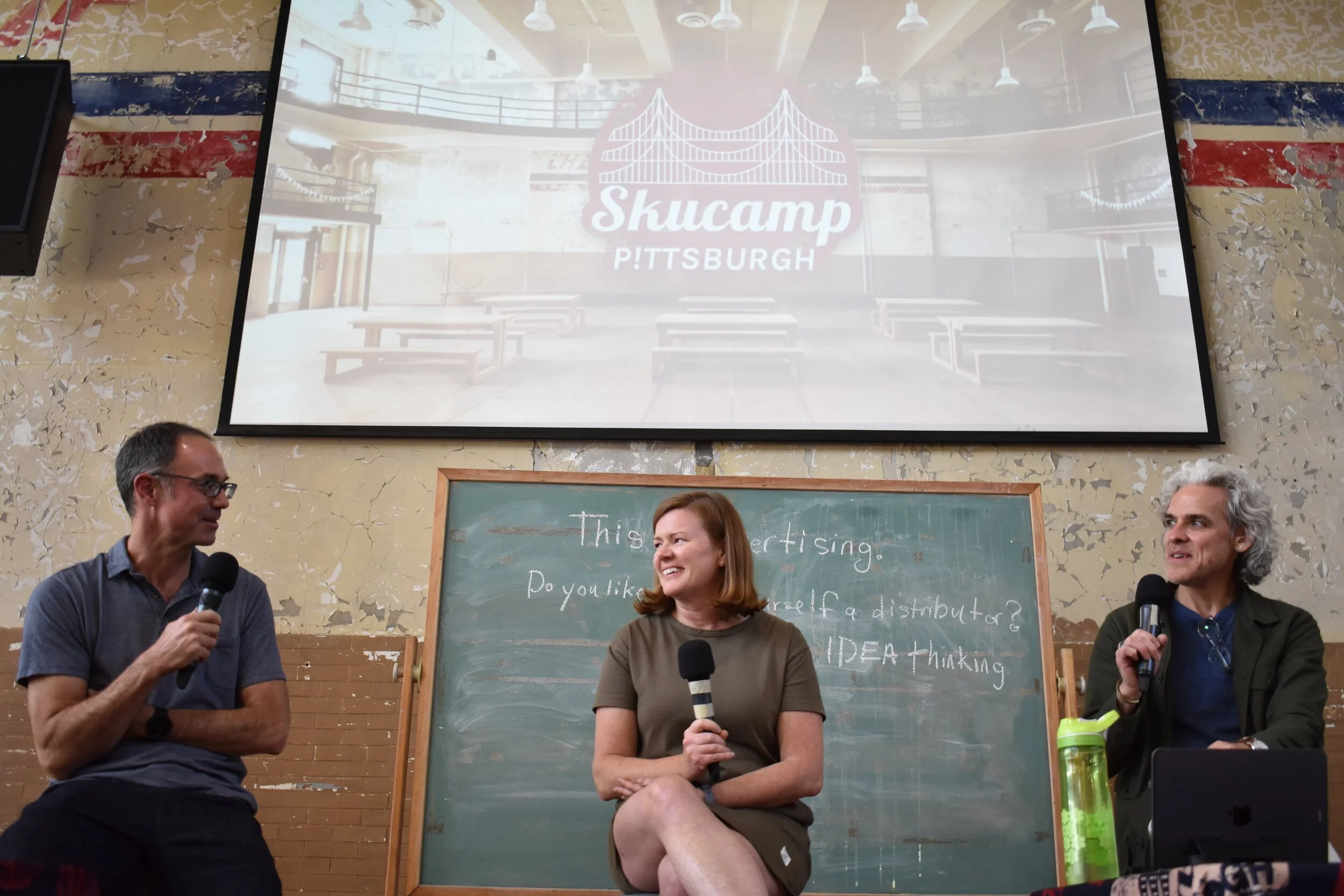skucamp 2019: The Aha! Moments (Act II)

This is Act II (Day Two) of our skucamp wrap-up, if you haven’t read Act I (Day One), you can check it out here!
The scene: The Ace Hotel, Pittsburgh
The setting: 3rd annual skucamp conference
Mood: Electric
Across the entire gym, nearly every cell phone suddenly lifts in the air for a pic.
SNAP.
It’s a quick shot. If actual cameras were used (and not cell phones), you would have heard the shutter click of over a hundred people, like paparazzi, collecting a moment. But instead of capturing a celebrity, they captured lightning in a bottle.
It’s that decisive moment in a presentation when an idea sparks, then ignites. It’s the lynchpin. The money shot.
Whatever you call it, it’s a wildfire.
It’s explosive because it’s more than a thought. It’s the culmination of sweat, blood, and tears behind the experience that brought the speaker to the stage. It’s the reason the speaker is standing in front of the crowd; it’s not their speaking talent, it’s because they’ve done something extraordinary. Something magical. Or maybe just something really damn hard and we suddenly realize it at that moment. And because of their vulnerability and willingness to share unselfishly, it’s our catalyst. It’s what Proust called a provocation: The speaker’s insight is our starting point for action.
Every speaker at skucamp had this moment.
Jay Acunzo, Keynote / Marketing Showrunners

Jay Acunzo and Mark Graham
For our keynote speaker, Jay Acunzo, there were many such moments. Jay dispelled the notion of creativity as merely being something “different,” and completely shattered our illusion about how real innovation occurs. In his talk “Break the Wheel: How to Escape Conventional Thinking to Overcome the Ordinary and Build the Extraordinary,” Jay revealed the secret to real innovation: incremental changes at the right moment.
Jay said, “If we want people to hold our brands in high esteem, if we want to consistently exceed expectations, we don’t need random, one-off stunts, we don’t need to panic-hop onto some trend that some expert says we have to do, we need small, refreshing changes on the status quo. That’s all we need to be memorable. Our problem isn’t selecting the one right thing … our problem is, that we’re not making enough small changes all the time.” Jay then broke it down for us through the process he called (humorously) “The Triangle of Tryin’ Stuff”:

Jay’s other big camera moment happened when he shared the four common traits found in high-performance teams that were consistently creative: intrinsically motivated (the process of doing the work is its own reward), exploration minded (teams that try small and consistent wrinkles all the time, not big and random stunts once in a while), momentum obsessed (building on top of results that compound over time), and usefully delusional (delivering something unique: conviction-over-consensus).

Jay said the secret lies in “constantly changing what’s working, while it’s working, adding little ‘wrinkles’ to it all the time… Most teams start with what’s broken and then try to fix it. Innovative teams start with what’s working then reinvent it. Innovation doesn’t require invention, innovation requires reinvention. Our customer’s expectations are constantly changing so our work better change constantly, too.”
David Nicholson / PCNA
David Nicholson is the President of Polyconcept North America (PCNA). In addition to joining us for the entirety of the conference, David led each morning’s run club for a jog around his hometown of Pittsburgh, taking runners on some of his favorite paths. Twenty-five years ago, he was serving pizzas and waiting tables when a placement agency called to offer him a job at a little start-up called Leed’s. From his initial work as an Import Manager to President, it has been an astounding career for “employee #4,” taking him on a journey that would give a first-hand view of the intricacies of worldwide trade. David has visited China and Asia over 75 times in his career and delivered a talk entitled, “A Supply Chain in Distress: 3 Issues Facing Us Today That Will (Re)Shape How We Source, Buy, and Sell Promotional Products.”

David addressed the issue everyone was concerned about right at the start, “Tariffs are certainly front and center, but I would argue that tariffs really are a symptom of a much bigger challenge.” He then proceeded to paint a bigger picture about our dependency on China, giving us a historical lesson on where the supply chain was, is at today, where we are heading, and what we must do to pivot toward a healthier supply chain.
It seems that almost every slide was a camera-moment in David’s presentation, as one insight gave way to another, but there were a few that helped put the challenges of our supply chain in perspective. “A picture is worth a thousand words,” said David, “we have become so dependent on China, that we now run a trade deficit that is about $400+ billion dollars.”

And with no simple substitute for China, the problem is immense:

In part two of David’s talk, he discussed “The Next Industrial Revolution” and shared what tomorrow’s supply chain would look like using the example of retailer, Zara. “Zara thinks about their supply chain, not in a linear fashion but as a collaborative process. It’s an ecosystem where everything is enabled by technology. Zara is incredible, they will introduce a product on the floor and within days start to feed back sales data to their factory, and the factory will adjust what it's producing based on that sales data. It gives them the ability, in real-time, to react to the data, replenish stock in a matter of weeks, (not months), and ultimately provide a much better customer experience. The result is having the right product on the shelves that customers want. As we think about what our supply chain in the future looks like, it is much more of this type of model.”

Lastly, David challenged us with two questions: 1) How do we change the perception (and actual reality) of the environmental impact of promotional products - throughout the supply chain? 2) How do we improve supply chain transparency and accountability within an industry where most suppliers have little visibility into the factories they are using?
Sara Webb / InTandem Promotions

Sara Webb began her career in the industry as a college student working for Nevins Group and in 2013, Sara opened InTandem Promotions, a creative and vibrant promotional products distributorship located in the Atlanta, GA area. Sara spoke about her journey, “From Salesperson to CEO: Shaping a Culture While Building a Company” and her cell phone moment was this:

Sara shared how she discovered, that as the CEO, she was managing, not leading, and had to learn new skills to adopt the right mindset for future growth. Sara said, “Fear is imagination with no direction. Faith is belief with direction. I was petrified to move into this new role of CEO and it took a lot of faith. So many times, we allow the voices in our heads to be our navigational lead guiding us to failure or to stopping. Do not let them take control … Do not allow the voices to win.”
Catherine Graham / commonsku
Catherine Graham followed Sara’s story with a practical session on “The Evolution of a Leader” and how to rethink your role to optimize growth when you become a “manager of managers.” She provided tactical ideas on how to structure and prioritize for growth, learning new skills that will enable you to drive the growth of the organization through (and alongside) others.

Catherine’s camera moment happened when she shared why and how most distributors fail to grow. Many distributors inadvertently become a bottleneck for their organization and prevent growth by not pivoting toward a leadership position that nurtures and trains future leaders, their model often looks like this:

“Ultimately, what ends up happening,” said Catherine, “is that you create this flat span-of-control, where you have way too many direct reports and too many priorities landing on your plate, suddenly you're not doing the kind of work you love anymore because you're spending all your time in the weeds.”
Catherine contrasted that with a high-growth leadership model:

Catherine challenged the audience, “If you are not being intentional about who it is that you want to be when you grow up, and if you do not set a leadership path for it, it becomes difficult to navigate and ultimately, difficult to attract talent. So, continually think ahead: What does your leadership roadmap look like? Who are you as an organization and who do you want to be in the next two to three to five years?”
But more than structure, Catherine also shared insights into what to do to supercharge growth once you get the right structure and people in place. She shared the three things a CEO should do, citing a well-studied article by venture capitalist Fred Wilson, that highlighted vision and strategy, talent, and money. Catherine also shared the current process we at commonsku are using for our own goal-setting, called OKR’s, written about by John Doerr in the book Measure What Matters.
Lastly, Catherine challenged leaders in the room to watch for the gaps in their own personal development, “We became a little bit obsessed with Monarch butterflies this summer up at my parent's place, north of the city. We had a little patch of milkweed, which is the only plant that Monarch caterpillars can feed upon, and it was interesting to watch their process of growth. When you think about your evolution as a leader, someday you're going to be a butterfly and you've got to know how to fly. Think about the gaps that you currently have within your own skill set, within your own background, the things that make you really, really uncomfortable; as you think about your next role and how you’re going to evolve, how do you fill those gaps?”
Jamie Mair / BDA
In an exclusive interview with BDA CMO and Swervepoint founder, Jamie Mair, Mark Graham sat down with Jamie to ask the hard questions. Jamie, famously introverted, erudite and yet approachable, took the stage with conviction and brutal honesty. He shared their journey from creating Swervepoint to eventually selling to BDA, tracking the original path from their unique value proposition, to how they shifted their approach in the market, and, eventually, how they managed to sell their business and why.

Citing Rockefeller Habits as one of their primary leadership resources, Jamie also detailed their struggles, sharing how the three partners co-led the organization, plus the challenges inherent in a decentralized leadership model. He provided the audience with a sober warning about a lack of intent with your business objectives, for example, he discussed their decision to get into program business, “because it was relatively easy” and how this shift in focus -from a highly creative, strategic business to an ops-heavy fulfillment model- dissipated their energies.

With anecdote after anecdote, Jamie provided examples of how to avoid misalignment with your goals and how to stay true to your original passion. “It all goes back to intent, be intentional. When you think of companies who are really awesome in this industry, they are all about intent. Don’t leave anything to chance. I can look around the room and see intentional businesses, Pierre with Chamelon is intentional. Denise, my dear friend from Fairware is intentional, Cathy with Redwood Classics is intentional. We all must commit to that discipline. Hindsight being 20/20, when I look back on all of our experience, it’s not that I wouldn’t have gotten into programs, or would have not made a particular decision, but I would have done things with intent, instead of just flying by the seat of my pants.”
Mark and Catherine Graham / commonsku
In what has become a skucamp tradition, our last session of the day featured our very own Mark and Catherine Graham on the subject of growth. I interviewed Mark and Catherine and asked, “You are running two successful businesses in this industry and you've faced a lot of hard times that people don't really know about. You also both have your finger on the pulse of the industry. You're talking to lots of business leaders. If there are a few secrets, key ingredients to strong, growth companies in this business, whether distributor or supplier, what are those ingredients?

Catherine responded using Jay Acunzo’s example of “usefully delusional” and cited a similar trait: relentless optimism, “You have to believe in your ability to pull it off. Everyone is going to go through challenging times, whether it's losing a great client, losing great people, or whether it's trying to figure out those next stages of growth. But ultimately, if you know that you've got it in you to pull it off, and that you can, you're going to continue to figure it out, and through trial and error, just stick with it. Entrepreneurs have to be relentless optimists.”
Mark shared a different trait, “The people I admire the most are the ones that have a relentless curiosity to just become better. I think it’s why I fell in love with the education side of this business, learning from all of the great people in our industry, learning from their experiences. People who are curious are learning and they are also the ones who are growing. At the end of the day, success is rooted in curiosity.”
Party’s End: Bring on the Axes
And finally, skucamp ended with everyone getting on target: Axe throwing.




skucamp Pittsburgh was one for the record books, many who attended stated that it had a different energy than any skucamp before:
skucamp 2019 was another well orchestrated and well executed event. No details missed, no stone unturned. skucamp makes you feel excited to bump into other attendees in the hall or on the way to a break or at a dinner, the camaraderie and networking at the event is SPOT ON! skucamp makes you want to learn and grow … inspires and leaves you feeling excited and motivated! - Johanna Gottlieb, Axis Promo
To our friends who joined us at skucamp this year:
On behalf of the entire skucamp team (Kate, Aly, Mark and Catherine, Aaron, Dave, Sam, and Bobby) we want to say thank you. As we design each of our events, we always design it based on the type of conference we would want to attend ourselves and we build the content around the most essential things we would want to learn. And then we show up and are knocked off our feet by the community: your energy, your passion, your friendship, and your love. The reward we receive from playing a small part in your success is fuel for our journey. Thank you for being you. Thank you for encouraging us and challenging us to reach ever higher.
To our friends who missed skucamp:
Though we’ve closed the curtain on skucamp 2019, skucon 2020 is right around the corner. Join us as we, once again, meet to ignite our imaginations, dream together, and inspire one another to become even greater versions of ourselves.
Your friends at commonsku -
PS. If you missed the insights shared from Day One, check out the post here!
